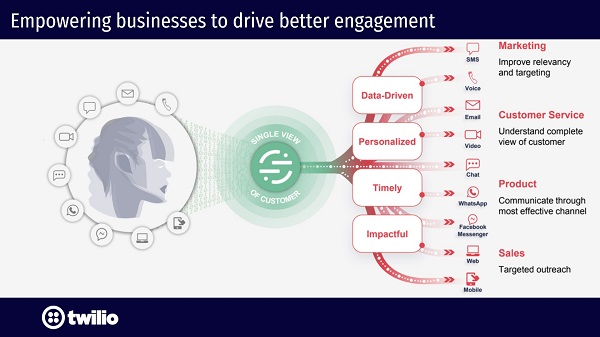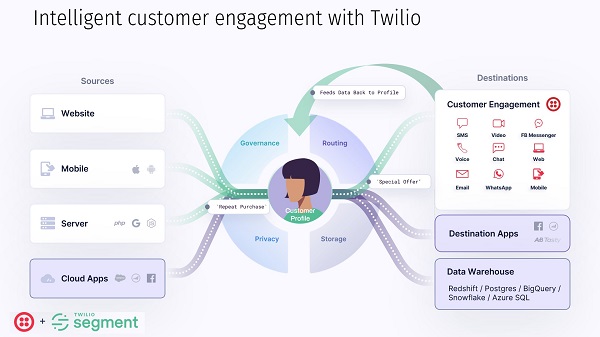Six months ago, when Twilio announced the
acquisition of customer data platform (CDP) leader, Segment, CEO Jeff Lawson said the intent was to help any business make its customer engagement across every channel more personalized, timely, and impactful. One part of that would be bringing Twilio’s contact center solution, Flex, together with Segment.
Fast-forward to late last month, and I got a glimpse into the progress of Twilio Flex plus Segment when I participated in a Twilio
webinar, “Guide to Personalizing Customer Experience.” During the webinar,
Katrina Wong, vice president of product marketing for the Segment portfolio at Twilio, described how the two platforms come together to provide customer value.
“One of the biggest challenges that we hear from customers, universally, is that their data is siloed. When data is siloed, it is really hard to get a single view of customers across the entire business,” said Wong, before showing how Twilio plus Segment can help. As shown in the graphic below, Twilio can now collect data from customer touchpoints, many of them digital, in the Segment CDP to provide a single view of the customer and connection to a variety of Twilio services.
From a customer service perspective, consolidating customer data in one platform allows companies to support agents with relevant context — a unified customer profile — in real-time, “served up to their fingertips,” Wong said. As seen in the graphic, customer service (and Twilio Flex) is just one of the services a company can enhance with the customer profile. It can provide value across the entire company, from marketing, to product management, to sales.
Double-clicking on customer service, Wong explained that once the data is organized, intelligent customer engagement is possible. By “intelligent,” she means engagement powered by AI and machine learning, which, she said, can only be accomplished “if you have good data underneath powering it.”
So how do Twilio Flex and Segment combine forces? “The data keeps up with the customer. How customers engage, and their preferences, are fed back continuously to refine the customer profile, and therefore produce the best customer engagement,” Wong explained. As seen in the second graphic, a company could use that information to create special offers or incent a customer’s repeat purchase.
To bring the notion of Twilio Flex plus Segment to life, Wong offered the case of an unnamed “major insurance company” that uses both platforms. This company had several different payment portals and repositories for policy information. Making all of this information available to the contact center support team meant one-by-one integrations with legacy technologies, she said.
To streamline the process, the insurance company leveraged Segment to capture data from websites, mobile apps, and backend servers. It then made that information available to agents through the customer relationship management (CRM) application via an API. Since implementing Segment, the insurance company has seen a 30% increase in first call resolution in the support center and has successfully encouraged more users to the self-support payment channel, Wong reported.
With this level of success, the insurance company has expansion plans for its Segment deployment. “The next horizon is to make recommendations, to upsell to existing policies, because they know more about the customers,” Wong said. For example, if an agent is speaking to a customer and knows that the household includes a teenager turning 16, the agent could proactively offer the right offer to dovetail with the existing policy.
Bringing thoroughly organized data to the agent sounds like the answer to a lot of contact center and customer prayers, but it doesn’t come without some effort. As Wong discussed, companies often assume that their data is clean and usable, but that is rarely the case. “Data is typically collected differently in different systems, making reconciliation nearly impossible,” she explained.
So before setting off on a path of creating a CDP and linking it to the contact center, a “best practice is to come up with a protocol on how you collect your data and make it consistent across the company,” Wong said. Without clean data, companies fall into the trap so many consumers face every day: You call a company to ask a question about an order and the agent just can't find the information. That's one of the problems Twilio and Segment is looking to solve.












